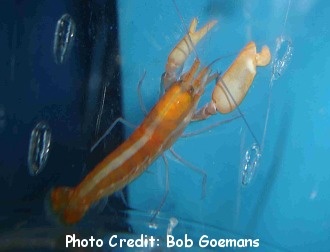
By Bob Goemans

Likely Reef Tank Suitable
Likely Fish-Only Tank Suitable
Range: Western Atlantic Ocean: Caribbean.
Size: 1.5 inches (4 cm)
Natural Environment: Inhabits rubble bottom areas living in association with the sea anemone Bartholomea annulata.
General Husbandry: Rarely available in the home aquarium trade.
Once in the aquarium, rarely seen, yet usually heard at night by snapping the fingers of its single, yet exceptionally large claw. Loud enough to awake light sleeping aquarists.
Best maintained in reef aquariums with hiding places or fish-only aquariums with lots of live rock for protection and possibly a host goby.
As to diet, late evening snacks of meaty foods, e.g., small strips of fresh fish/shrimp flesh, sinking shrimp pellets or meaty freeze-dried foods placed near the area where it hides during the daytime will help reduce the nose it makes at night while hunting and/or provide some of its nutritional needs.
Taxonomy:
Kingdom: Animalia
Phylum: Arthropoda
Class: Malacostraca
Order: Decapoda
Family: Alpheidae
Genus: Alpheus
FYI: Let me insert here a note from a reader; I found your picture of the Anemone Pistol on the web. I happen to have one and he has been thriving in my tank for about 1 year. I got him from a supplier out of TX. He is beautiful! Very reclusive. I have a Yellow Watchman that did live wit a tiger pistol until about 11/2 months ago. The tiger pistol died after about 3 years. The Goby has not paired up w/the Anemone Pistol as of yet. I am not sure if he will. I am toying w/the issue of getting another Tiger Pistol for my Goby. Anywho, just some notes on the Anemone Pistol. When he got here to Atlanta, I thought that he was dead and he almost went to shrimp heaven. He played dead in the transport bag for the entire acclimation. I was not sure of the behavior of them since there is no info on the net about them, so I got a small plastic strainer and placed him in it at the top of the tank. (55g long) After at least 4 hours, I thought that I saw him move, so, I dropped him in the opposite side of the tank from the tiger pistol. He was on his side for at least 2 hours wedged between rocks. I was trying to figure out how I was going to get him out. Anyway, about 2:30am, I got up to check on the new arrivals and he was gone! I assumed that the other scavengers got him and took him to eat. About 2 weeks later, I heard a loud "snap" that was not the same tone as my Tiger Pistol. I started paying attention to that side of the aquarium more. Eventually, he started moving the sand and appearing slightly at feeding time. I began hand-feeding him to catch him up on nutrition. He has grown remarkably well! He has the most beautiful markings and gorgeous neon blue legs! He stays to the bottom of the tank and all anemones are at the top in the high flow. I have 8 of them. He eats meaty foods, silver sides, krill, frozen brine and mysid. He will also eat pellet food and flake when fed that. So, I hope that this helps you w/more info on them. He bothers no-one. He lives w/a Coral Banded Shrimp, many hermits & snails, 1 Pink Skunk Clown, one Royal Gramma, and a mated pair of Black Percula Clowns. There are also MANY species of coral and 8 anemone. One happy community! Thanks! Le Ann MacDougall
Experience Level: Intermediate
Diet: Carnivore
Temperament: Peaceful
Aquarium Environment: Reef or fish-only aquarium
Coral Safe: Yes
Fish Safe: Yes
Invertebrate Safe: With caution
Acclimation Time: Shrimp are 'very' sensitive to specific gravity/salinity changes. Therefore, be sure to adjust the bag's water to that of the aquarium in which it will be placed by slowly adding small amounts of aquarium water to the bag every few minutes. In most cases, this process should take at least 15 minutes.
Aquarium Hardiness: Moderately hardy
Calcium (Ca): 380 - 430 mg/l
Alkalinity: 2.5 - 3.0 meq/l
Phosphate (PO4): <0.05 mg/l
Magnesium (Mg): approx. 1350 mg/l (relate to specific gravity) Extremely important for molting!
Strontium (Sr) 8 - 10 mg/l
Iodine (I) Trace element additives containing iodine should be used as recommended by their makers, as iodine is also vital for the molting process.
Temperature Range: 72 - 83°F (22 - 28°C)
Minimum Tank Size: 30 gallons
Lighting: PAR ratings N/A
Water Movement: WM 1 - 2
Specific Gravity: 1.023 - 1.025
pH: 8.0 - 8.4
